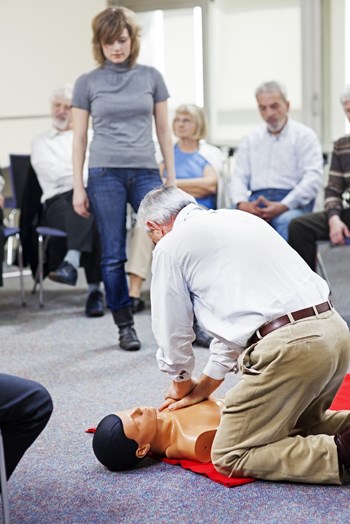
A fire breaks out in an apartment building; A broken water pipe floods several floors; A resident collapses with a heart attack on the tennis court; An intruder roams the premises with criminal intent; A huge alligator settles in for a nap on the seventh tee of the community’s golf course. In every case, fire rescue and police personnel are summoned, and they rush to the scene. Until professional first responders arrive however, the situation is in the hands of the community’s on-premises staff and security providers. How does a concierge, doorman, maintenance worker, security guard or property manager learn to deal with such emergencies? In south Florida, training is available from many sources.
Local emergency-management agencies offer free training for community staff and residents through their Community Emergency Response Team (CERT) programs. Some property-management companies have training programs for their clients’ staff. Other sources include non-profit organizations and for-profit companies that sell training classes, printed materials and videos.
CERT Training
Statewide, Florida has 125 CERT programs. For a complete list, visit www.citizencorps.fema.gov/cc/CertIndex.do?submitByState.
“We’ve trained about 750 people since 1998 from within the city of Boca Raton and the surrounding area. We don’t turn anybody away,” says Norm Engel, division chief, special operations for Boca Raton Fire Rescue Service and Boca Raton’s CERT coordinator and lead instructor. Engel’s CERT classes meet three hours a week for nine weeks. The curriculum covers:
Fire science- which includes fire prevention and how to put out a fire. Participants go outside, practice using a fire extinguisher, and learn to handle a heavy 1.75-inch hose line on hydrant pressure. This session also covers hazardous materials. “Many people store ammonia and bleach next to each other,” Engel says. “If they come in contact, the bleach breaks down to hydrochloric acid, which then reacts with the ammonia to form a toxic vapor called chloramine.”
Disaster medical operations- including anatomy and physiology, triage (classifying victims based on how soon they need treatment), and a head-to-toe assessment of a victim awaiting treatment.
Disaster preparedness- covering what supplies are needed, in what quantity, where to store them, and how to use them. Other topics include how to turn off electric, natural gas, and water utilities; making sure people on medication have an ample supply; deciding whether to stay or evacuate as a hurricane approaches; and checking on elderly neighbors.
The psychology of disaster and terrorism- “If you’re out on the street and see something horrible, you become a victim yourself,” Engel says. “Recognize when someone is getting emotionally overloaded. Give frequent breaks, let people talk, provide for debriefing.” This session also discusses the devices terrorists use. “We teach ‘see something, say something.’ Raising the awareness of the nation has helped law enforcement stop a lot of potential terrorist activities,” he says.
Search and rescue - “The impetus for CERT training was the major earthquake that struck Mexico City in 1985,” Engel says. Untrained would-be rescuers went into unstable structures and saved 800 people, but 100 of the rescuers were killed when aftershocks caused further damage. That prompted the Los Angeles fire department to start training people not to become victims themselves. FEMA accepted the concept, took it nationwide, and expanded it to apply to all kinds of emergencies and hazards.
Post-storm procedures - including what to look for and expect, and how to organize teams to expedite the recovery effort.
A simulated disaster drill- using Fire Explorers (teens in a Boy Scouts of America program) as victims. “We use a full moulage kit to make these kids look a mess,” Engel says. “Then we scatter them out, and brief the incident commander and team on what happened. The instructors follow the teams around and coach if they need help. Afterwards we debrief, talk about it, then have a party.”
After graduation, CERT teams support their local communities by assisting with emergency education and responding to emergencies as needed.
Other Courses
The American Heart Association offers courses in first aid, CPR, and the use of an automated external defibrillator (AED). They are available in a classroom setting in multiple locations, or online, for a fee. For information, visit www.heart.org and search on courses.
The American Red Cross offers courses in administering emergency oxygen, blood borne pathogens training, emergency medical response, first aid, and CPR/AED at multiple locations in south Florida, for a fee. For information, visit http://www.redcross.org/take-a-class and enter your zip code.
Where a building or community does not employ security guards, staff members with other primary responsibilities may find security-guard training a useful skill set and credential. Schools that offer such training must be licensed by the Florida Department of Agriculture and Consumer Services. Applicants for a Florida Class D Security Guard License (for guards who don’t carry firearms) must complete 40 hours of training before submitting their application, or 24 hours before applying and 16 hours within the next six months. Other requirements to be licensed include fingerprinting, passing a written exam, and a background check. For information, visit http://www.securityguardtraining hq.com/ and click on Florida.
Training at Boca Pointe
Boca Pointe is a 1,000-acre master-planned community located just outside the city of Boca Raton at the south end of Palm Beach County. It includes the Club at Boca Pointe, with an 18-hole, Jack Nicklaus-designed golf course; the Boardwalk commercial center; and over 4,000 residences within 29 separate villages. About 7,500 people live there. Housing types include condominiums, townhomes, garden villas, single-family homes of various sizes, and two assisted-living facilities.
Kathryn Danella is general manager of Boca Pointe Community Association (BPCA), the development’s master association. “We don’t manage any of the individual villages,” she explains. “Our responsibility is anything that affects the overall community.”
BPCA has a nine-person administrative staff, and outsources its landscape maintenance and guard functions. “If you’re contracting for services,” advises Danella, “make sure the vendors have on-going training for their employees. In your contract, demand that they offer it.”
AlliedBarton Security Services provides 55 people to staff BPCA’s entry gates and roving patrols. The landscape vendor has an 18-person staff.
“We create the specifications they have to follow,” Danella says. “We approve protocols for clearing residents and visitors to enter the community and direct the roving patrols where to go and how often. Our roving patrols are certified as first responders in CPR, basic first aid, and AED use. If they’re first on a scene, they can try to stabilize someone before fire rescue gets there.”
To train her own staff, Danella hires outside trainers certified in teaching CPR and other desired skills. “Use professionals, so you make sure the information that gets out there is correct,” she says.
Boca Raton’s CERT program has trained Danella and two of her staff members, and about 75 Boca Pointe residents. “We maintain and facilitate their on-going training, and provide several walkie-talkies,” she says. “They are trained to use a defibrillator. There is one in the clubhouse; the CERT people could step in and use it.”
Training at Valencia Palms
Valencia Palms in Delray Beach is a 612-unit community with a population of about 1,000 active seniors over age 55, managed by Boca Raton-based Lang Management Company. Meghan DeLuca, manager of the Valencia Palms Property Owners Association, is a Lang employee.
“Lang has a training and education staff member who brings us classes and information on training,” DeLuca reports. “We’ve received training in first aid, CPR, choking, and how to use an AED. We have three talking AEDs. The staff knows where each one is, and has been trained in how to use them. If it wasn’t talking, they would know what to do.
“The pool is always a concern, with visiting children and grandchildren. We have no lifeguards. People swim at their own risk. We encourage them to follow all safety measures, and we have rules and regulations posted. The staff knows where the lifesaving equipment is to pull somebody out of the pool.”
Valencia Palms also has close to 50 CERT-trained residents who participate in monthly training sessions. They are ready to mobilize, and have radios that reach across the community.
An outside contractor oversees the community’s front gate. “We’re always told they are not security, they are access control, they don’t carry guns,” DeLuca says. “We’re instructed that whatever the situation, if we feel threatened, we should call 911 to let the people who are trained to handle it handle it. The CAM (community association manager) materials frown on security training because of liability, since we’re not trained and licensed as security agents.”
George Leposky is a freelance writer and is a frequent contributor to The South Florida Cooperator.






Leave a Comment